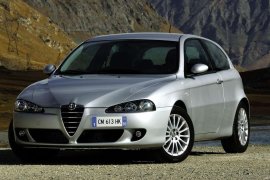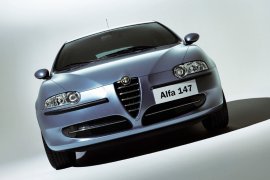ALFA ROMEO 147 3 Doors Models/Series Timeline, Specifications & Photos
First production year: 2000
Engines: Gasoline, Diesel
Body style: Hatchback
The first generation released in 2000 was a huge success and the Alfa Romeo 147 was one of the best-looking cars on the market.
However, the car was on sale for five years without any major updates, thus, it was time for a revised model.
In 2005, the Italian carmaker unveiled an excitingly styled Alfa Romeo 147, with design cues takes from the sporty Brera: sharper headlights, a revised bumper with more aggressive intakes, body colored rubbing strips, larger rear lights, a redesigned lower bumper and a redesigned tailgate.
Besides the exterior updates, the new Alfa Romeo 147’s cabin was refreshed with better quality soft-touch materials, as well as redesigned instrument for better reading.
Other updates included a revised suspension designed to provide more comfort, revised damper settings and more driver aids systems such as antilock brakes, brake force distribution and stability control.
In 2005, the Italian producer updated the engines range, offering more powerful diesel units: the 1.9-liter 16-valve unit that previously developed 140 hp was now offering 10 extra ponies, while the other versions of the 1.9-liter unit offered 115, 120 and respectively 170 hp.The gasoline engine offering remained the same.
The engines could be mated with a brand new robotised gearbox, a development of the renowned Selespeed named Easyspeed.
With the Alfa Romeo GTA’s production ceasing in in 2006, the Alfa Romeo 147 remained the most powerful car in Alfa’s range.
The GTA badge had a long history in the Alfa Romeo family, and it was always installed on performance vehicles. The 147 was no exception.
The hot-hatch era was at its peak at the beginning of the 2000s when Alfa Romeo decided to enter the segment with a special version of the 147 range. The Italians were already known for their ability to tweak an otherwise bland car into a track-weapon. The 147 GTA was no exception.
From the outside, the GTA version was almost like a factory sleeper. There was a small detail at the front bumper, where the apron received an aggressive styling that could warn a trained eye. The specific light-alloy wheels were designed especially for the GTA version. But then again, both were available as parts in the Alfa Romeo catalog. A dual exhaust in the back was subtle enough to pass unnoticed.
The interior was not significantly different than the regular 147. But the bucket-seats in the front and leather upholstery were superior to those found on the base model. A set of aluminum pedals and a tachometer marked up to 8.000 rpm showed something more about the car.
Under the hood, there was a racing heart: a V6 unit that offered 250 Italian horses. That was no joke, and the 300 Nm (221 lb-ft) confirmed the status of a real hot-hatch. It provided power and torque on the entire range, and the lack of any turbo-lag made the car fight against the finest sports cars in its class.
The 147 hatchback was launched as a 3-door hatchback in 2000 and the 5-door version followed after. The car was designed to revamp the Alfa Romeo presence in the compact-segment.
While the big, 164, was a success story for Alfa Romeo, the rest of the lineup was not. The 146/147 range was not appealing for the customers in one of the most important segments. The change had to be done. The 156 brought the brand back on the market with high sales due to its styling and great platform with independent suspension in all corners. Being aware that the platform will be a success, Alfa Romeo built the compact 147 on the same platform.
The three-door version looked like a hot-hatch even with the smallest engine available. It looked fast from every angle. The doors featured a subtle sculptured line and black frames for the windows. In the back, the V-shaped rear windscreen and the angled taillights mounted high on the quarter-panels enhanced the dynamic look.
Inside, the bolstered front seats were separated by a low mounted center console, but with an integrated armrest for the driver. A three-round dial instrument cluster featured four gauges and an LCD in the middle for the on-board computer. In the back, there was limited room for two adults due to the thick front seats.
Apart from the 3.2-liter GTA version, there were other four choices fitted with a choice of diesel and three with gasoline engines, ranged from 100 hp to 150 hp. The standard transmission for most versions was a 5-speed manual, and only the 1.9-liter 140 hp diesel version was fitted with a 6-speed manual. For selected versions, a 5-speed automated (electronically controlled single clutch) gearbox was installed.


